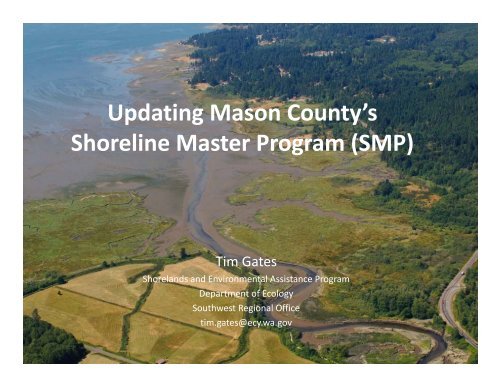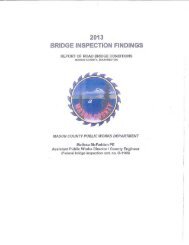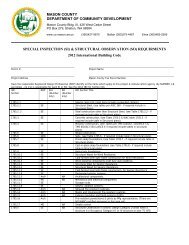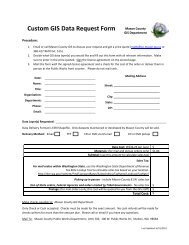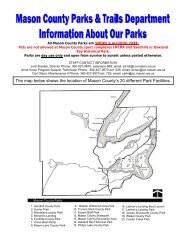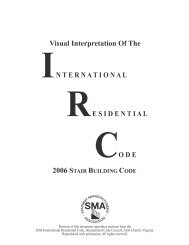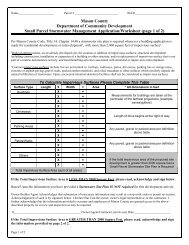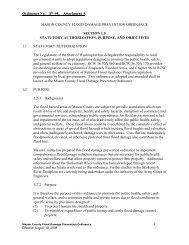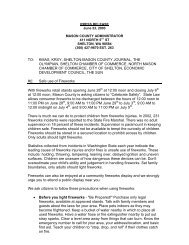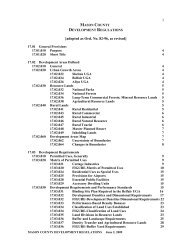Shorelines - Mason County
Shorelines - Mason County
Shorelines - Mason County
You also want an ePaper? Increase the reach of your titles
YUMPU automatically turns print PDFs into web optimized ePapers that Google loves.
Updating <strong>Mason</strong> <strong>County</strong>’sShoreline Master Program (SMP)Tim GatesShorelands and Environmental Assistance ProgramDepartment of EcologySouthwest Regional Officetim.gates@ecy.wa.gov
I. Introduction ti to Washington’sShoreline Management Act (SMA)– History, state policy– How it works: Policies, i Regulations, Permits,DesignationsII. <strong>Mason</strong> <strong>County</strong>’s Update Process
Shoreline Management Act of 1971“ prevent the inherent harm in anuncoordinated and piecemealdevelopment of the state’sshorelines”“plan for and foster all reasonableand appropriate uses”A resource‐management approach:not a single‐mission statuteGov. Dan EvansRCW 90.58.020
Policy goals of the SMA require balance• Plan for priority uses that require ashoreline location (e.g., aquaculture)• Protect environmental resources ofstate shorelines (“No Net Loss”)• Promote public access and enjoymentof publicly‐owned shorelines• While recognizing and protectingprivate property rightsRCW 90.58.020
How it works: State law directs policy/procedureState LawShoreline Management ActAdopted by State LegislatureRCW 90.58State RuleGuidelinesAdopted by EcologyWAC 173‐26Local OrdinanceLocal OrdinanceShoreline Master ProgramAdopted by Commissioners<strong>County</strong> Comp Plan and Code
Ecology rules flesh out detailsState LawShoreline Management ActAdopted by State LegislatureRCW 90.58State RuleGuidelinesAdopted by EcologyWAC 173‐26Local OrdinanceLocal OrdinanceShoreline Master ProgramAdopted by Commissioners<strong>County</strong> Comp Plan and Code
Counties and cities write and implement SMPsState LawShoreline Management ActAdopted by State LegislatureRCW 90.58State RuleGuidelinesAdopted by EcologyWAC 173‐26Local OrdinanceLocal OrdinanceShoreline Master ProgramAdopted by Commissioners<strong>County</strong> Comp Plan and Code
SMA is a unique local‐state partnershipCounties and cities:Ecology:• Develop local ShorelineMaster Programs (SMPs),based on Ecologyguidelines, tailored tolocal circumstances• Administer the program(permits, compliance)• Writes guidelines• Technical assistance• Formal approval of SMPs• Final action on certainpermits– Conditional Use Permit– Variance
Where does the Shoreline Act apply?• Marine waters• Lakes > 20 acres• Larger streams (>20 cfs mean annualflow)• “shorelands” 200’landward from wateredge, or “OrdinaryHigh Water Mark”(OHWM)
SMPs are comprehensive use regulations<strong>Mason</strong> <strong>County</strong> SMP has 3 sections + mapPolicies<strong>Mason</strong> <strong>County</strong>ComprehensivePlanChapter 9:<strong>Shorelines</strong>Regulations<strong>County</strong> CodeTitle 17.50Permit/appealProcedures<strong>County</strong> CodeTitle 15EnvironmentDesignations
Policies: set overall intention and direction<strong>Mason</strong> <strong>County</strong>ComprehensivePlanChapter 9:<strong>Shorelines</strong>• Express a commitment to act in acertain manner• Interpret, give support to, andexplain the regulations• Usually expressed as “should”Example of existing SMP Mining policy:“All practical measures should be taken to protect water bodiesfrom all sources of pollution, including sedimentation and siltation,chemical and petrochemical use and spillage, and storage ordisposal of mining i wastes and spoils. Maximum protection ti shouldbe provided for anadromous fisheries' resources.”
RegulationsPolicies<strong>Mason</strong> <strong>County</strong>ComprehensivePlanChapter 9:<strong>Shorelines</strong>Regulations<strong>County</strong> CodeTitle 17.50Permit/appealProcedures<strong>County</strong> CodeTitle 15EnvironmentDesignations
Regulations: specific, definitive requirements<strong>County</strong> CodeTitle 17.50• Performance standards andspecific bulk, height ordimensional standards• Use the verb form “shall”Example of an SMP regulation that implement the policy:“Mining activities that will permanently impede, or retard the flowor the direction of flow of any stream or river shall not beallowed. Surface runoff from the site carrying excessivesedimentation ti and siltation ti shall not be allowed to enter anyshoreline waters.”
Regulation chapter headings in current SMP<strong>County</strong> CodeTitle 17.50SMPsregulated awide range ofuses andactivities• Agriculture• Aquaculture• Commercial Development• Marinas• Mining• Residential Development• Utilities• Ports and Water‐Related Industry• Bulkheads, Breakwaters, Jetties And Groins• Fill• Dredging• Flood Protection And Shoreline Stabilization• Transportation Facilities• Piers and Docks
Not all activities are regulatedNot Regulated:• Ongoing timbermanagement/harvest• Ei Existing i & ongoing agriculture• Recreational shellfish harvest• Boating, fishing
Permit/appeal procedures: intro to key terms/processPolicies<strong>Mason</strong> <strong>County</strong>ComprehensivePlanChapter 9:<strong>Shorelines</strong>Regulations<strong>County</strong> CodeTitle 17.50Permit/appealProcedures<strong>County</strong> CodeTitle 15EnvironmentDesignations
“Substantial development” triggers permit<strong>County</strong> CodeTitle 15“Development” = new structures, dredging,drilling, dumping, filling, removing sand/gravel;bulkheading; placing obstructions; bt ti etc.“SubstantialDevelopment” =developments that costmore than ~$6,400
Conditional Use & Variance permits: Ecology approval<strong>County</strong> CodeTitle 15ConditionalUse: uses thatmay be allowedsubject toincreasedscrutinyVariance: permits thatallow variation from bulk,dimensional andperformance standards (likebuffers or height limits)Criteria for granting Conditional UseCriteria for granting Conditional Useand Variance permits in state rule
“Exemptions” = exempt from permit requirements<strong>County</strong> CodeTitle 15Exemption: certainactivities exempt frompermit, though notstandards d (e.g., normalmaintenance and repair,Single Family house &bulkhead)Permit exemptions are in state laws/rules
Permitting is a public process<strong>County</strong> CodeTitle 15Advertise inpaper, post site,mailings within300 ft., 30‐daycomment periodHearings examinerreview: publichearing, followed byappeal period
Permit decisions appealed to State Hearings Board<strong>County</strong> CodeTitle 15SMP permitdecisions areappealed tothe state<strong>Shorelines</strong>Hearings Board(SHB)The SHB is now part of the Environmental and Land UseHearings Office
Shoreline permit history (1971 – 2009)Note: even “permit‐exempt”activities follow SMP standardsLast 10 years, avg ~ 25permits/year
Environment designationsPolicies<strong>Mason</strong> <strong>County</strong>ComprehensivePlanChapter 9:<strong>Shorelines</strong>Regulations<strong>County</strong> CodeTitle 17.50Permit/appealProcedures<strong>County</strong> CodeTitle 15EnvironmentDesignations
Environment designationsA map that “overlays” countyzoning map (NOTE: zoning isnot being changed as part ofthis update)Classifies similar shorelinesinto different categoriesExisting designations fromleast to most restrictive:• Urban• Rural• Conservancy• Natural
“Designation table” indicates how uses are regulatedExample from existing SMPP = “Permitted” (Allowed, if consistent with regulations. May or may not need a Permit.)C = “Conditional Use Permit” (May be allowed if meets criteria)X = Prohibited (Use not allowed in that environment designation. May be exceptions.)
I. Introduction to Washington’sShoreline Management Act (SMA)II. <strong>Mason</strong> <strong>County</strong>’s Update– <strong>County</strong> update process– Tips on how to review draft products1975: <strong>Mason</strong> Co.adopts first SMP1988: <strong>Mason</strong> Co.amends SMP2013: <strong>Mason</strong> Co.SMP update due
Why update <strong>Mason</strong> <strong>County</strong> SMP now?• Legislature set schedule for all SMPs to be updated• Legislature providing money – a fully funded deffort. <strong>County</strong>using grant for staff and consultant help.• Current SMP is dated (last amended 1988).• Conditions have changed. <strong>County</strong> added 20,000 residents since1990.• Expect ~24,000 more residents by 2040 (2012 OFM forecast).• New state guidelines: Ensure regulations accommodategrowth and shoreline use without damaging lands and water.Basic environmental standard: “No net loss” of ecologicalfunctions. Update with current scientific information.
Ecology guidelines: “No net loss” of ecological functionsBaseline is current conditions. Assumes development will occur.Individual projects should avoid impacts where possible, mitigatefor unavoidable impacts
Local update processTwo advisory groups appointed by<strong>County</strong>/City yCommissioners:• Technical Advisory Committee(reviews technical products)• <strong>County</strong> Citizen AdvisoryCommittees (CAC) helps draft SMPPlanning Advisory di Committeemakes final recommendation toBoard of <strong>County</strong> Commissioners(BOCC)BOCC hearings final action (targetBOCC hearings, final action (targetis mid‐2013)
Local SMP update processIdentify shoreline jurisdictionShoreline Inventory/Characterizationt ti3‐yearpublicprocessEnvironment Designations, RegulationsRestoration planLocal and state adoption
<strong>Shorelines</strong> in <strong>Mason</strong> <strong>County</strong> Type # waterbodiesMilesRivers 63 337Lakes 44 149Marine PS/Hood 217Total shoreline miles: 703<strong>County</strong> used 100‐year floodplain forshoreline planning area
Local SMP update processIdentify shoreline jurisdictionShoreline Inventory/Characterizationt ti3‐yearpublicprocessEnvironment Designations, RegulationsRestoration planLocal and state adoption
Inventory and Characterization report• Relies on existingstudies and GIS data• Map folio• Characterize existing iticonditions• Used to inform“environmentdesignations”
Map Folio: countywide maps• 23 maps• Available at <strong>Mason</strong><strong>County</strong> website bit
Characterization: Organized by watershed and “reach”More details forindividual reachesChapters start withgeneral descriptionof broad areas:• Physical character• Water qualityissues• Critical areas• Land Use
Reach sheets“Baseball card” format,with summary stats:• Physical and EcologicalFeatures• Built environment andland useAlso identifies“Opportunity Areas” forprotection andrestoration
How shorelines were “chunked” into reaches• Land use, zoning• City/UGA/RAC boundaries• Environmental conditions:Marine: drift direction, waveand current exposure, shoretypeRivers: gradient, confinement,confluence of streams,tributary input pointsLakes: typically one reach
Local SMP update processIdentify shoreline jurisdictionShoreline Inventory/Characterizationt ti3‐yearpublicprocessEnvironment Designations, RegulationsRestoration planLocal and state adoption
Proposed new environment designationsRetained:• Natural• Conservancy• Rural• Urban (now only for UGAs/RACs)New:• “Residential” (for more denselydeveloped urban‐ish areas outsideUGAs)New:• “Aquatic” for areas belowOrdinary High Water Mark
Designations based on Ecology criteriaUsed Ecology guidelinesas basis.For each type ofenvironmentdesignation, set primaryand secondary criteriabf before applying li to map.Used information incharacterization report
Example of data source used in criteria• As one indicator of existingconditions, used Puget SoundNearshore Ecosystem RestorationProject (PSNERP) marineshorelines “process degradation”ranking• The overall degradation d scorewas one of secondary criteriaused to determine designations(e.g., “Least Degraded” usedtogether with other data toinform “Natural” designation)
Committees helped refine criteriaJoint meetings ofTechnical and CitizenCommittees usedsample reaches to helprefine designationcriteriaCriteria are a blend ofexisting conditions andfuture community vision(e.g., comp plandesignation and zoning).Can be challenging!
NOTE: Connection to Characterization ReportIf you wantmore infoabout areach
Updating regulations: Some overall CAC principles• Keep Comprehensive Plan vision in mind• Don’t start tfrom scratch, thchange only where needed ddto:• Meet Ecology guidelines• Correct problems in current SMP• Integrate with other more recent regulations• Tailor regulations to local circumstances• Improve efficiency and predictability in regulations• NOTE: CAC interested in• NOTE: CAC interested in“incentive” approaches (would liketo identify more options in SMP)
Context: <strong>Mason</strong> <strong>County</strong> Comp Plan vision<strong>Mason</strong> <strong>County</strong> will remain a primarilyrural county where residents will enjoypeace and quiet, privacy, naturalviews, and rural enterprise. Althoughrural character means different thingsto different people, aspects of itinclude: natural vistas, wildlife, andnatural ecosystems; ; fewer restrictionsand more privacy than in an urbanarea; the easy operation of resourcebased industries such as timber,mining and agriculture; and the closeties of family and community to theland.‐ <strong>Mason</strong> Co Comprehensive Plan , 2005
Vision for Urban AreasThe City of Shelton and thecommunities of Belfair andAllyn will serve as the <strong>County</strong>'sprincipal economic, civic, andsocial ilcenters. Each will have acore business area anchored byretail, service industries,government, and educationfacilities. The three urban areaswill provide a strongemployment and tax base.‐ <strong>Mason</strong> Co Comprehensive Plan , 2005
Vision for Rural AreasNatural resources will continue to provide thefoundation of the <strong>County</strong>'s economy.Forestry, agriculture, aquaculture includingshellfish and other fisheries industries, Christmastree farming and mining will provide employmentfor <strong>County</strong> residents. The <strong>County</strong>'s abundance ofnatural amenities including mountains, lakes,rivers, and wildlife will continue to support the<strong>County</strong>'s thriving tourist industries....The <strong>County</strong>'s land use regulations will protectnatural resource lands and industries againstencroachment from incompatible, competinguses.‐ <strong>Mason</strong> Co Comprehensive Plan , 2005
“Issue papers” for each section of the SMP• Introduction to topic andEcology guidelines• Summary of existing SMP• How the issue is addressedin existing comprehensiveplan and other regulations• Proposed regulations(h (shown in strike tikthrough/underscore)
Some key issuesAdvisory Committee still workingon final details, final draft Jan 2013Beach‐friendly shore armoringCritical areas, buffers, setbacksNew state geoduck rulesPiers and docks
Critical areas, including buffers and setbacksCommittee recommends relyingon existing Resource Ordinance.Vary application in shorelines onlywhere necessary.The Resource Ordinance:• designates all shoreline areas ascritical areas (saltwater, rivers,lakes)• includes regulations to protectfunctions, including buffers,setbacks, requirements forHabitat Management Plans, etc.
Lots of overlap between shorelines and critical areas<strong>County</strong> CAOSMPSMP covers marinewaters, larger streams,lakes over 20 acres
Bulkheads: Ecology guidelines very specific• Overall goal: avoidunnecessary armoring• Geotechnical report:applicants must provideevidence of need, ensureother options such as drainagehave been addressed,determine appropriateapproach for site• New development should belocated to avoid the need forstabilizationUse “soft shore”approach whereverlocal conditions allow
Piers and docks• Regulations still being revised• Incorporate relevantrequirements of federal andstate tt agencies with regulatory ltauthority• Challenges: balancingpredictability and flexibility,addressing other regulationsthat are in the midst of change
New state commercial geoduck rulesConditional Use Permit toestablish a new commercialgeoduck farm (except whereconverting)Farm applications to includeextensive info, including:• Baseline ecological survey• Management practices toaddress impacts from mooring,parking, noise, lights, etc.• Monitoring andreporting requirements• Allowance for workduring low tides
“Grandfathered” structures• <strong>County</strong> consideringincorporating new optionprovided in law to classifyexisting “grandfathered”residences inside id buffers as“legal, conformingdevelopment”• This option addressesconcerns raised by somehomeowners about theirhouses being labeled “non‐conforming” structures
Restoration planIdentify shoreline jurisdictionShoreline Inventory/Characterizationt ti3‐yearpublicprocessEnvironment Designations, RegulationsRestoration planLocal and state adoption
Restoration plan: currently under reviewIdentifies voluntaryrestoration opportunitiesIncludes general“programmatic”recommendations for allshorelinesSite‐specific projectp p jrecommendations forpublic shorelines only
Restoration project database• Existing projects (e.g., <strong>Mason</strong> CD, HCCC, SPSSEG, tribal govt’s)• Additional areas (e g in saltwater areas good places to nourish• Additional areas (e.g, in saltwater areas, good places to nourishbeaches, enhance stream mouths, or remove tide channelconstrictions)
Local and state adoptionIdentify shoreline jurisdictionShoreline Inventory/Characterizationt ti3‐yearpublicprocessEnvironment Designations, RegulationsRestoration planLocal and state adoption
Next steps in local process• Finish CitizenAdvisory Committeereview (through hDecember)• Planning AdvisoryCommission reviewand public hearing(starting January)B d f C t• Board of <strong>County</strong>Commissioners reviewand adopt (target:June 2013)
Ecology approves SMP after <strong>County</strong> adoptionEcology approval required by theShoreline Act. Ecology must helpimplement the SMP. Ecology defendsSMP if challenged in court.Ecology goals:• Engage throughout• Clearly communicate expectations• Avoid surprises• Work through issues early<strong>County</strong>AdoptionEcology Comment PeriodEcology Decision•Approve•Require Changes•DenyFinal Local Approval60 Day Appeal period
More information<strong>Mason</strong> <strong>County</strong>: Google“<strong>Mason</strong> <strong>County</strong> SMP”LaJane Schopfer(360) 427‐9670 x408LaJaneS@co.mason.wa.usEcology: Google “EcologyShoreline Citizens Guide”Tim Gates(360) 407‐6349tim.gates@ecy.wa.gov


